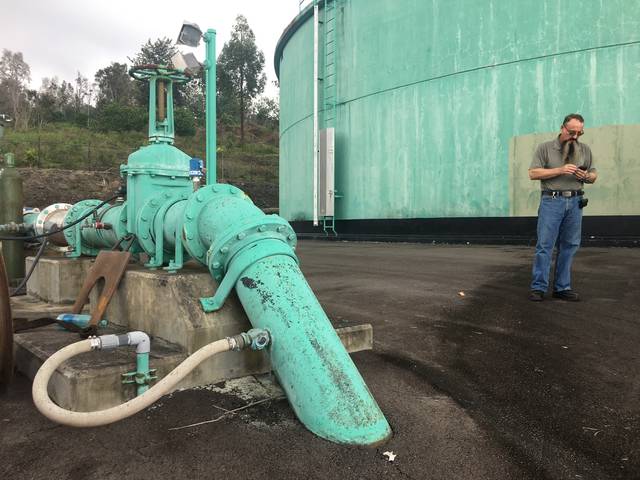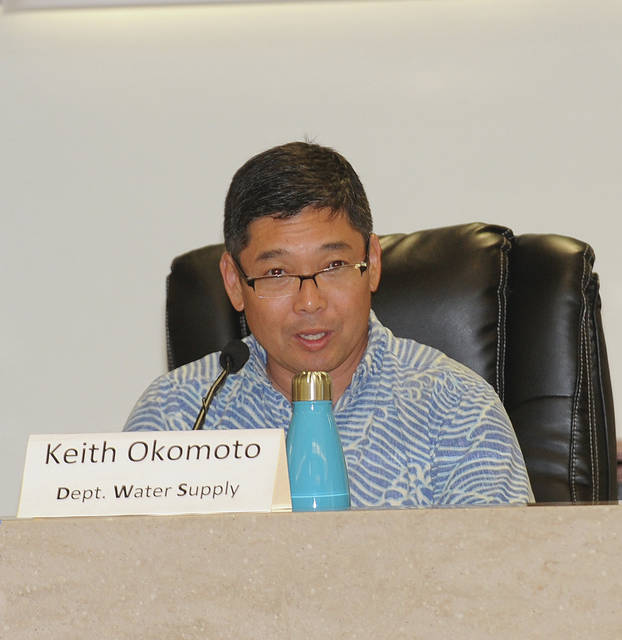KAILUA-KONA — The Hawaii County Water Board and Hawaii County Department of Water Supply intend to pull out all the stops to address North Kona’s water crisis, including opening up their proverbial wallet.
Craig Takamine, Water Board chairman, said that could mean hiring more DWS staff, paying consultants from the mainland to help with a system audit the board is currently mulling, or paying more for higher-end equipment.
“I’m a fan of really spending more on the front end than on the back end,” Takamine said following a Water Board meeting last Tuesday. “If we can pay a little bit more for higher quality materials, I definitely want to look and see if that’s possible.”
Part of the consideration will include whether higher quality equipment can be procured islandwide. Takamine said he would be hesitant to favor North Kona facilities over other Hawaii County water systems just because of recent problems.
And it remains unclear if equipment quality has contributed to the rash of premature equipment failures that have knocked out five of North Kona’s 13 wells, including several crucial wells at the Palani, Hualalai and Honokohau sites.
At the same meeting last week, Takamine indicated the board’s intent to initiate an audit of the system.
The audit will tackle questions about the standards set for equipment and if those standards are too low, the procurement process in general, testing stipulations written into bid contracts to ensure quality equipment is delivered to Hawaii Island and storage practices to ensure the equipment remains in good condition after it arrives.
The precise composition of the audit commission has yet to be ironed out, but Takamine indicated he’d like to set it to purpose within the next month. The task force would potentially include members of the Water Board, DWS employees, members of the private sector who operate their own water systems and potentially a consultant.
“We can try to identify consultants that can help with the overall assessment, but for that we may have to go to the mainland,” Takamine explained. “Because of procurement that kind of stuff would take time. It’s really important for us to act now.”
DWS is currently working at individual sites to determine precise causes of equipment failure at each one, another top goal of the audit.
Identifying management guidelines for the future
Takamine said the board has made contact with someone from the American Water Works Association, a nonprofit that has for nearly a century provided guidelines and standards for water utilities to treat, store and manage water resources.
AWWA guidelines and standards are voluntary but are utilized to some degree by roughly 55,000 members in more than 100 countries across the world, according to the AWWA website.
Takamine was unsure last week as to which AWWA guidelines and standards, if any, Hawaii Island’s water system might adhere.
“I don’t think I can answer that question at this time,” he said.
Keith Okamoto, DWS manager and chief engineer, said DWS references AWWA publications from time to time to inform its management, although that has typically been restrained to “technical standards and guidelines.”
AWWA also provides instruction on equipment storage, equipment monitoring and risk assessment, and timely procurement of replacement and back-up equipment to meet crucial system needs.
Both Okamoto and Takamine said they’re open to consulting and implementing more AWWA guidelines and standards in management practices moving forward.
“We’ve just reached out to an engineer with AWWA who will see if his network of experienced folks in the pump and motor field may be of assistance,” Okamoto said.
AWWA recommends an annual audit like the one Takamine is organizing, but it’s not something the board and DWS have done on a consistent basis.
“I would say (an audit) would have to be done on an as-needed basis,” Takamine said. “But this particular audit is strictly to address the issues we’re having in West Hawaii.”
Costs
Okamoto said DWS operates 70 wells across the island but employs just three mechanical engineers. Takamine said hiring more technical experts is on the table.
However, cost also looks to play a significant factor in choices moving forward regardless of what the audit uncovers. Hiring more engineers would drive up costs and employing a mainland consultant for the audit itself could also prove a potentially pricey endeavor.
The board plans to approve and order more back-up equipment to provide a safety net against future equipment failures, but that can quickly deplete coffers, especially if storage practices lead to more failures. Such equipment typically has a warranty of one year, which is one reason Okamoto used to explain why DWS hadn’t stored more back-up parts for crucial wells to this point.
Okamoto said all the extra repairs required due to the recent string of well malfunctions, along with a planned shift in the future to a more redundant system at crucial sites, are poised to take the biggest bites out of the budget in months and years to come.
“Repair costs currently are the highest expense,” Okamoto wrote in an email to West Hawaii Today on Monday. “Strategy for future well development for the construction of dual lower capacity wells instead of a single large capacity well is expected to increase CIP (capital improvement) expenses for future wells.”
Nestorio Domingo, a Water Board member, addressed the redundancy strategy in a letter to the editor sent Friday afternoon.
“The cost of adding a secondary well onto the existing single deep well systems could be relatively high due to additional pumps and related components, but it should pay for itself and (be) worth the investment in the long run,” the letter read.
DWS does receive some grant money for CIP projects, but most of its funds come from the rates it charges customers. In a busy North Kona system comprised of approximately 11,000 accounts pumping around 12 million gallons of water daily, the current water restrictions are impacting DWS revenues.
In other words, contingencies and future planning require more money, but because of current water restrictions, DWS and the board will have less funding upon which to draw.
Okamoto addressed whether this might mean rate hikes in the future.
“Not at this time,” he wrote. “Our rates are determined after conducting a rate study, which involves various factors including operating costs and projected capital improvement project needs.”
He added the next rate study has not yet been scheduled. He did not provide a timeline for when one might be initiated.
To bolster water resources in case of another failure, potable water tankers have been strategically placed across North Kona. One was at the top of Hina Lani street as recently as late last week. These are manned 24 hours per day, seven days per week — another cost DWS is incurring as repairs to offline deep wells continue.
Okamoto said all other DWS projects across the island that are either currently underway or have been fully planned will retain earmarked funding.
Inspection and testing considerations
DWS is not equipped with the technical expertise necessary to test deep well pumps and motors on its own. Thus, testing and inspection requirements are actually written into bid contracts.
Up until now, the only mandatory test required by manufacturers and distributors was a factory pump test to measure flow, head and efficiency of the pump — one of two crucial deep well components along with the motor. That test is witnessed by an independent third party before the equipment is released for delivery.
Full string testing, which measures the equipment’s ability to handle the full, expected workload at full speed, have not typically been written into contracts.
Okamoto said the reason full string testing has mostly been excluded involves moisture that is sometimes introduced to portions of the motor if it is “not properly prepared prior to shipping.” Such exposure can cause premature failure down the line.
“For future procurement, the department will be including string testing for critical wells and additional requirements to overcome the issue of moisture in the motor,” Okamoto wrote. “The plan is to have the new certified inspections performed at the manufacturer or testing facility prior to delivery.”
Okamoto said in an interview earlier this month that DWS intends to include mandatory equipment tests for critical dimensions as a part of new inspection guidelines.
Critical dimensions are unique tasks and strains equipment will have to endure to function effectively and with longevity in North Kona’s deep wells. Such tests have not been included in any procurement contracts to this point.
Takamine said he wants several such tests to be administered by a third party not just before equipment is shipped, but also after it arrives. As it is, DWS typically inspects equipment visually upon arrival, but that process is substantially limited diagnostically.
“It’s a long trip from the mainland to here, and you never know what happens,” he said.
Of course, writing such stipulations into contracts may drive up bid costs. Local contractors who work with DWS on equipment procurement, testing and installation are few, and they tend to bid against one another on project after project.
The only guaranteed way for DWS to refill its coffers and pay for extra costs is to raise customer rates, although other avenues like increased government grants might be possible.
The blame game
Another portion of the system audit will include a review of DWS storage practices. Some equipment is vacuum sealed before it’s shipped to the island, but not all of it.
DWS has tended to store equipment in such packaging to protect against corrosion. But Okamoto said in an interview last week that process may need to be revisited.
“We need to look at weighing the pros and cons of keeping that in the sealed package,” he said. “We can not store them for too long in that one position, so at some point we need to spin them. If it sits too long in that one position the shaft (ends up bent).”
If equipment is to be tested upon arrival, that would already require it be removed from vacuum sealed packaging. DWS and the board are likely to convene discussions with manufacturers to determine how frequently spinning, or equipment rotations, should be administered.
While Takamine said the audit should provide some insight into who or what is at fault for North Kona’s water crisis, he said he’s not interested in playing the blame game.
“At this time, what the board is looking to do is really find solutions to these issues,” he said. “We need to go back and try and figure out what happened at each particular well along the way, but we’re not really focused on who’s to blame at this point.”
It must be noted, however, that locating the source of the problem or problems leading to widespread deep well equipment failure is crucial to fixing those issues and avoiding them in the future. That can’t be done without assigning blame. It’s simply a byproduct of the process now underway.
Takamine assumed responsibility for finding those answers and was willing to shoulder some of the culpability for North Kona’s water crisis along with DWS.
“Ultimately, the Water Board is equally responsible as (DWS) for all the issues that have happened,” he said. “If we can’t find solutions, they should probably find somebody else to take my place.”









